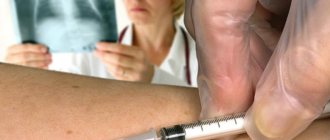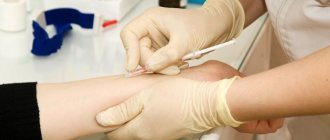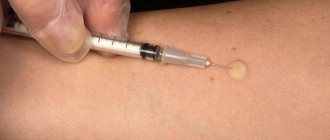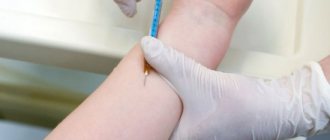X-rays instead of Mantoux are performed for certain indications or when parents refuse tuberculin diagnostics. Doctors believe that Mantoux is more informative because it allows you to detect the presence of Koch's bacillus in the body and diagnose tuberculosis in any location. X-ray is advisable only for diagnosing already developing pulmonary tuberculosis.
According to Federal Law No. 77, parents have the right to refuse any research and analysis as part of anti-tuberculosis measures. In case of pressure from medical workers and refusal to admit a child to preschool/school institutions, it is worth referring to the Federal Law, because departmental acts that contradict it are not mandatory.
When can you take x-rays instead of Mantoux?
X-rays instead of Mantoux can be done only in certain cases:
- the child has been diagnosed with an allergy to injected tuberculin;
- there are medical contraindications to performing the Mantoux test;
- parents voluntarily refuse tuberculin diagnostics.
Bronchial asthma is an absolute contraindication to the Mantoux test
Mantoux and fluorography are the same thing
Mantoux and fluorography are not the same thing, because the manipulations are radically different:
- Mantoux test - subcutaneous injection of tuberculin, which allows you to find out the body's reaction to it and understand whether Koch bacilli (the causative agent of tuberculosis) are present in the body;
- fluorography is an examination of the chest that allows one to identify an already developing disease in the respiratory organs.
We recommend reading about blood tests for tuberculosis instead of Mantoux. From the article you will learn about in what cases Mantoux can be replaced with a blood test, types of laboratory blood tests for tuberculosis, and their comparative characteristics. And here is more information about what doctors think about the Mantoux vaccination and whether it is necessary to do it.
Radiography
X-rays in children are used only for strict indications. For the purpose of preventive examination, for example, to detect tuberculosis, it is not used. This is due to the negative impact of ionizing radiation on a growing child’s body. The younger the child, the more harmful and dangerous X-rays are for him.
It’s another matter if the patient has clinical manifestations of tuberculosis, a sharply positive Mantoux test, data from other additional studies (tuberculosis bacilli in the sputum, antibodies to tuberculosis in the blood) and it is vital to confirm the presence of a tuberculosis focus. In this case, an X-ray of the lungs is performed; or the spine, bones of the extremities in extrapulmonary forms of the disease.
To minimize the effect of ionizing radiation on the child’s body, it is better to perform an x-ray using a digital device, with the mandatory use of protective equipment (lead apron, protection of the thyroid gland and genital organs).
Thus, it is not entirely correct to compare diagnostic techniques such as the Mantoux reaction and x-rays. The tuberculin test is a screening diagnostic technique; it is not always accurate, but is accessible to all segments of the population. X-rays are taken according to strict indications, after examination by a doctor and all necessary studies, when it is important to confirm the presence of a tuberculosis focus.
Harm from radiation to a child
When conducting an X-ray examination in children, the following must be considered:
- X-ray is powerful radiation with no adaptation;
- the close location of the child’s organs contributes to a greater impact of rays on the body;
- In children, sensitivity to radiation is 2-3 times higher than in adults, which creates a risk of negative changes in the body, incl. genetic.
What does the law say about x-rays instead of samples?
According to the law of the Russian Federation, instead of the Mantoux test, x-rays cannot be given to children under 14 years of age unless the parents give their consent. The law clearly states that the Mantoux test is carried out for prophylactic purposes for early detection of Koch bacillus infection. It turns out that replacing tuberculin diagnostics with x-rays is also a preventive measure, and to carry it out, doctors need to obtain the consent of official representatives of the person being examined.
Federal Law No. 77, Article 7, paragraph 3 clearly states:
...anti-tuberculosis care for minors under 14 years of age is provided with the consent of their legal representatives.
Current legislation does not provide for any consequences for refusing Mantoux - specialists cannot insist that the child undergo additional examinations and undergo specific tests.
What is more harmful for a child, what is safer?
What is more harmful or safer - Mantoux or X-rays for a child - no doctor can answer. The fact is that these manipulations do not cause the development of tuberculosis, and in the case of x-rays, not a single case of the development of radiation sickness in a child has been recorded.
The Mantoux test can provoke the development of a severe allergy, which can be treated with antihistamines. X-rays are also now a safe procedure for minor children - irradiation is carried out in small doses and according to a clearly planned frequency schedule for the procedure.
With modern X-ray machines, the child receives a minimal dose of radiation
What is better and more effective – Mantoux or X-ray
Doctors believe that the Mantoux test will be better and more effective than x-rays:
- tuberculin makes it possible to detect the presence of Koch's bacillus in a child's body, even if symptoms of the disease are completely absent;
- Mantoux makes it possible to diagnose tuberculosis localized in any organ or system;
- An x-ray will show only existing pathological foci in the lungs.
Watch this video about the types and signs of tuberculosis on x-ray:
Linked immunosorbent assay
If the child is unvaccinated and the parents refuse to take Mantoux, the likelihood of developing tuberculosis increases, since the presence of mycobacteria will not be detected in a timely manner. Despite the fact that there is a certain law, not all parents are satisfied with the safe method of diagnosing tuberculosis by administering Tuberculin. Of course, parents have the right to refuse permission to perform the Mantoux test, but then the diagnosis will have to be carried out in a different way.
Many people are interested in whether ELISA (enzyme-linked immunosorbent assay) gives a reliable result and what advantages does it have? Phthisiatricians warn parents that this examination method cannot be considered a full-fledged alternative to the tuberculin test. Using it, you can only identify the rate of development of an existing disease. That is why this technique is completely useless as a preventive examination.
Nevertheless, doctors’ reviews of the enzyme immunoassay are extremely positive; it has the following advantages:
- deciphering the results is carried out quickly and takes no more than a day;
- this type of diagnosis is very informative;
- After such an analysis, the presumptive diagnosis can be confirmed or refuted.
Enzyme immunoassay is a necessary examination method, but it is intended for other purposes, so it is not advisable to use it as a diagnosis of tuberculosis.
How to avoid trouble due to refusal of a lung x-ray instead of Mantoux
Often, when parents refuse an X-ray of the lungs instead of Mantoux, doctors take a hostile position and do not allow the child to enter kindergarten or school. In fact, this behavior of medical workers does not comply with Federal law, and parents can defend their rights. It is necessary to start a written dialogue with doctors and the head of the clinic and in the first appeal be sure to indicate the following:
- your full name and what became known about the preliminary decision to prohibit the issuance of a medical certificate for admission to a kindergarten or school;
- emphasize that this is categorically contrary to Federal Law and refer to Art. 32 (consent to medical interventions for a child under 15 years of age is given only by their official representatives), Art. 5, paragraph 1 (the right of citizens to refuse vaccinations and other manipulations as part of the prevention of tuberculosis);
- indicate knowledge of Art. 7, paragraph 3 (any anti-tuberculosis assistance to minors under the age of 14 is provided only with the consent of their official representatives);
- mention the Constitution of the Russian Federation, Article 43 of which states the right to education, including preschool education, regardless of religion or health status.
A written dialogue with representatives of a medical organization should begin only after the child has undergone a general medical examination and received reports on the state of health from an ENT specialist, ophthalmologist, surgeon, orthopedist, and has taken blood, urine, and stool tests for enterobiasis and worm eggs. Supplement these data with a description of the patient’s health status (no hyperthermia, no excessive sweating, weight is within normal limits, appetite is not reduced, and so on).
At the end of the statement, it is worth emphasizing that any departmental documents that contradict Federal Law are illegal and cannot be enforced.
The application is drawn up in 2 copies; if one of them is not accepted at the medical institution, then it is worth sending it by mail with acknowledgment of receipt. The next step, if pressure continues on the parents, is a visit to the prosecutor's office with the previous application (copy) attached.
We recommend reading about how to write a refusal from Mantoux. From the article you will learn about the reasons for refusing Mantoux, how to write a refusal, the consequences, and visiting a TB doctor afterwards. And here is more information about why to visit a TB doctor after Mantoux.
An X-ray instead of Mantoux can be done as part of the detection of tuberculosis, but only if the parents agree to such a study. According to the Federal Law, representatives of minors under 14 years of age may refuse tuberculosis prophylaxis and any tests as part of its diagnosis in the absence of a clear clinical picture of the pathology.
The role of PCR, ELISA and RNG in the diagnosis of the disease
Polymerase chain reaction is a highly accurate method for testing the presence of tuberculosis. It is also used to identify hereditary pathologies, viral diseases and inflammatory processes of any etiology. With its help, an experienced doctor can make a diagnosis with a minimal amount of biological material.
A distinctive feature of the method is the ability to detect pathology 3-4 hours after infection, before the first signs of the disease appear.
Diagnosis is carried out by collecting biomaterial from the child with further determination of what type of pathogenic pathogens the identified microorganisms belong to. The results obtained are assessed using molecular and genetic methods. It takes an experienced specialist several hours to identify Mycobacterium tuberculosis, after which he establishes a residual clinical diagnosis.
Despite the fact that polymerase chain reaction is one of the most accurate research methods, if a tuberculosis infection is suspected, it is used in cases where additional examination methods have not given clear results. This is due to the high cost of materials used for diagnostics.
PCR, in addition to its high efficiency, has other advantages, due to which it is one of the most popular procedures for detecting foci of infection with Koch bacilli.
Among them it is worth highlighting:
- Maximum safety for the child's health.
- No absolute contraindications.
- Possibility of diagnosis in the case of infants.
- Detection of pathogenic microorganisms at all stages of disease development.
The indirect hemagglutination test is a serological diagnostic method that is also used to detect tuberculosis infection. The use of RNGA is recommended in controversial cases when other research methods have not given an accurate result. The procedure requires special training, with which you can obtain the most accurate diagnosis.
These rules include:
- collection of biological material is permitted only on an empty stomach;
- before performing the analysis, doctors do not recommend drinking large amounts of liquid, since this directly affects the rheological properties of the blood, which leads to false results;
- The day before the procedure, smoking and drinking alcoholic beverages is prohibited.
Enzyme immunoassay is not considered a full alternative to the Mantoux reaction. Using this diagnostic method, the rate of development of an existing pathology is determined. In this case, the primary diagnosis of tuberculosis using ELISA is useless.
However, TB specialists respond positively to this study, since it has a large number of significant advantages.
Among them it is worth highlighting:
SENSATION! Follow the link:
MRI for pulmonary tuberculosis
- quick interpretation of the results obtained, which in most cases does not take more than 12 hours;
- high test accuracy, which exceeds the level of 98%;
- With the help of analysis, a preliminary diagnosis can be refuted or confirmed.
The use of these diagnostic methods is justified in cases where other research methods are not recommended for a particular child or are not highly effective. Their implementation is coordinated with an experienced specialist, who excludes the presence of contraindications.











